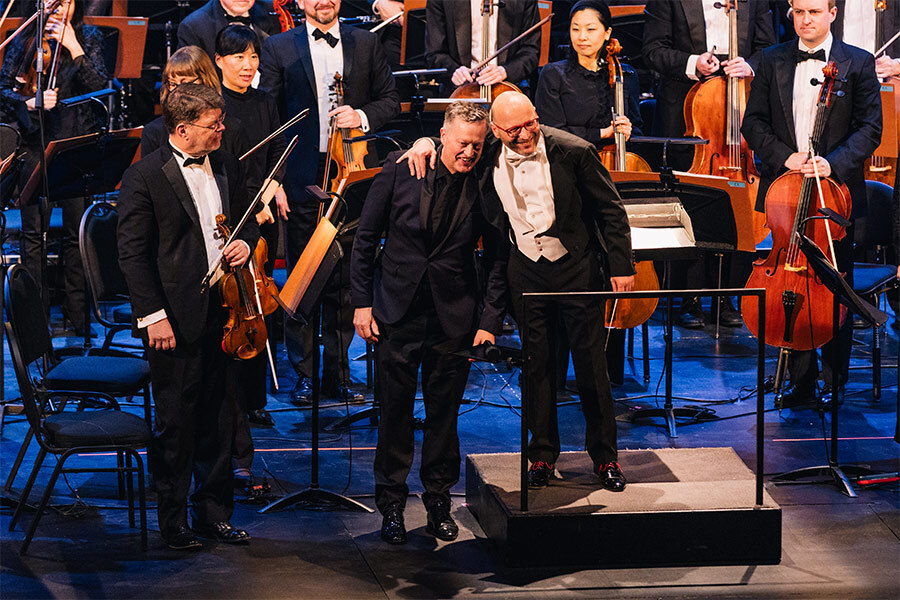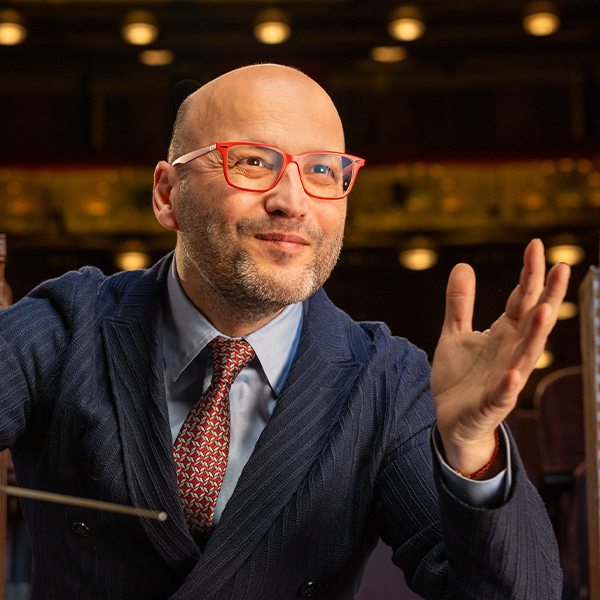October 23, 2025
Michael Black on "Carmina Burana"
Fortune favors the prepared
With the 2025/26 Season underway, Lyric’s Chorus Director and Head of Music Michael Black took a moment out of rehearsals to discuss the history and grand scale of Orff’s Carmina Burana and a few exciting firsts for the Lyric Opera Chorus and Chicago audiences.
The Lyric Opera Chorus starts the 2025/26 Season with a bang! How has it been preparing such different pieces at the same time?
The start to the season has been insane for us. We've been rehearsing nonstop every day, all day. We opened the season with Medea, a Lyric premiere which was a new opera for everyone in the Chorus — and myself. Then, we're doing the double bill Cavalleria rusticana and Pagliacci, which was unfamiliar to a surprising number of members of the Chorus. It has a big scene for them — two big scenes! Then, we're rehearsing Carmina Burana, which is another huge thing, as well as rehearsing A Night of Mellon Collie and Infinite Sadness, the big Smashing Pumpkins extravaganza in November. I thought the Chorus would be involved in a few little items here and there, but the Chorus is onstage the entire time, singing 18 songs, three of them with Billy Corgan. So it's been a great start to the season.
This is the first time Lyric has performed Orff’s Carmina Burana, but it’s a widely known piece. What makes it so approachable?
Whether it's a Gatorade ad or an episode of How I Met Your Mother or Nas back in the 90s, rapping with Carmina Burana playing in the background, or watching The X Factor, everyone knows Carmina Burana on some level.
Audiences probably won't come out humming the tunes from Carmina Burana because Orff wrote it deliberately without melodic interest in mind. It's driven purely by huge orchestral forces and driving rhythms — almost primitive primal rhythms — rather than beautiful melodies. You get a couple of beautiful melodies. But even the opening that everyone knows only contains three or four notes; they're just repeated in different iterations. So you come out humming three or four notes. But the rhythm, the huge percussion section and the hemiola (a rhythmic device where two groups of three beats are expressed as three groups of two beats, or vice versa) and the driving primitive rhythmic force is what people come out remembering.
To hear it with an opera chorus of 100 and an orchestra almost mirroring that number as well is something that's going to be quite remarkable. Hearing 100 of Chicago’s best opera singers brings it to an entirely different level.

Lyric’s Chorus Director and Head of Music Michael Black.
Are there any challenges that this piece presents when learning it and preparing it?
Melodically, it's not that riveting, but rhythmically and textually it is. Some of the greatest challenges in rehearsing this piece for a 21st-century chorus is the language itself. We’re looking at medieval German, 12th- and 13th-century Latin. Latin is a real challenge because no one quite knows how it's pronounced.
Every chorus director in the world thinks they know what it all means, but no one does. We make it up a little bit, and just make sure that everyone in the Chorus is doing exactly the same thing. So that's a big challenge.
Some people may have sung it elsewhere, and they've pronounced words slightly differently, but it's the color of the text which is really important. When we started rehearsing with the tenors and basses, we went straight to the tavern scene, which is incredibly wordy — just word after word after word after word, never ending for about four minutes of this pitter patter of 13th-century German text. It's great! It's a lot of fun doing it, but it's a real challenge for the Chorus.
This piece was written in the 1930s, but it's based on a much older text. Can you talk a little bit about the history of Carmina Burana?
I find the history of this piece really fascinating. It was a huge success at Frankfurt Opera in 1937, and Orff immediately wrote to his publisher and said, “Now you can destroy everything I have previously created and you have unfortunately printed.” He knew it was a success. He knew how important this piece was.
The 25 poems that are set within this piece are really fascinating because they talk about love and fortune, and how fickle both can be. Look at the picture these poems are based on, which is Rota Fortunae — the wheel of fortune. We start with fortune being really fickle, and we move through spring, and the meadow, and the tavern, and this love story, and we come back to fortune at the end. So this was the original wheel of fortune.
Orff was really obsessed with the simplicity of music. So it's not about complex counterpoint or fugal writing or layers of orchestra writing. It's just primitive forces presenting primitive rhythms, and text which was meaningful during the medieval period, but Orff is saying the messages are just as meaningful to us today: fortune, love, nature, religion — both sides of religion. Fascinatingly, we talk about all these things in this one hour of music.

Maestro Enrique Mazzola joins Chorus Director Michael Black and members of the Lyric Opera Orchestra onstage for remarks following a remarkable performance of A Wondrous Sound.
These poems cover a wide range of topics. Do you think it's important for the audience to understand the context and the stories that are being told in order to enjoy the music?
Carmina Burana is one of these pieces where you can just sit there, shut your eyes, and let the music wash over you — all the sounds and colors. Or, you can look at the supertitles and find out exactly what's being said, because a lot of these poems are written by various people in the 12th and 13th century, and they cover such a wide variety of human emotion. It's kind of nice to match the emotion to what's actually happening on stage. If it's a really driving, loud section of music, you wonder “Hey, why is that so loud?” And the two loudest sections, of course, are at the beginning and end where it talks about fortune and how we're all at the mercy of fortune in life.
The piece is incredibly serious, but there are moments of great levity. When the swan is being burned and the singing is incredibly high because he's in agony, it's kind of this black humor, which is bizarre and funny and weird and beautiful all at the same time. The texts are all about life, and lust, and gluttony. So it's a piece imbued with great depth and then other moments of great levity as well.
How does this compare to recent choral offerings at Lyric?
For the past few years, Lyric has been trying to present a choral piece every season. So we’ve done Beethoven’s 9th, the Mozart Requiem, and A Wondrous Sound — a real showcase of operatic choruses. And yet? Carmina Burana is the biggest and most ambitious choral project that we've undertaken in Lyric's history. We've never had a choral concert with 100 singers. So, if you came to the Requiem, think of something twice as big, twice as impressive. We have the chorus raised a lot higher so that the sound will come out over the orchestra much more because the orchestra is so big. We have 50 children from Uniting Voices Chicago walking out on stage to sing their parts. So it's a bit of a visual spectacular as well as a choral spectacular.
Because this was created as a scenic cantata, do you think it gives the chorus more to grab on to when finding the meaning and emotions?
Symphonic choruses are amazing, but giving this task to an opera chorus is something else; the opera chorus is used to creating characters. It's used to coloring words innately, finding the raw emotion in the text, and then relaying it to the audience through amazing voices. For many people in the audience, hearing an opera chorus do this piece will be a once-in-a-lifetime experience.
There’s a lot of new music this season. What else are you looking forward to this season?
It's an interesting season! We're performing Madama Butterfly, and while the opera has been performed here many times, we're doing a different version of it with music that's never been sung at Lyric. Composers often tinkered with their compositions before and after opening night, and Puccini was no different. We're doing the 1904 Brescia version of Butterfly, so the chorus has new music to learn that no one has ever sung before. I've never taught it before! So that's exciting. We've also never performed El último sueño de Frida y Diego and Mellon Collie. So even though there are familiar pieces in the repertoire there are a lot of firsts. A lot of new stuff that Lyric audiences have never seen, that we're enjoying putting together.
Experience the wonder of Carmina Burana for three performances only, beginning Friday, November 14. Learn more and get your tickets for Orff's epic choral masterpiece at Lyricopera.org/CarminaBurana.

